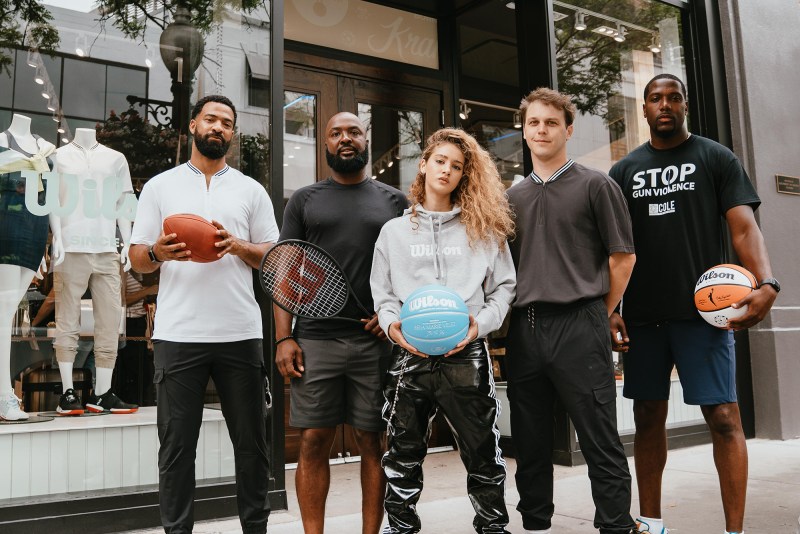
Wkwesi Williams tells me to keep my arms straight, body upright, and to step forward when hitting a tennis volley. “Good things happen when you engage the core,” he says from the other side of the net. We’re in Chicago near the lakefront on a muggy, overcast day in mid-July, the diamond façade of the Crain Communications building looming overhead, and despite the fact that our respective flights will depart in opposite directions in a few hours, we’re here, just outside of the service boxes, working on the fundamentals.
Related Guides
Williams, a former tennis pro who now teaches out of Los Angeles, was brought to Chicago by Wilson, the Chicago-based sporting equipment maker, to celebrate the opening of its first brick-and-mortar location. The new store showcases the company’s recently released Sportswear line, a lifestyle-slash-activewear collection it developed through the feedback of athletes and influencers, including Williams himself. And it’s what we wear for this tennis lesson: Slim mid-thigh shorts and three-button polos that, while made from modern materials, draw their inspiration from the company’s hundred-year-plus history of sports manufacturing. Granted, Wilson may be better-known for its hard-good innovations — the ubiquitous neon yellow tennis ball, which made the sport visible to the TV viewer, and the valve-inflated football, which revolutionized the passing game and essentially made Tom Brady possible, just to name a few — but athletes have to wear something, and the company dutifully obliged. More than a century after its founding, Wilson is drawing inspiration from its own deep well.
The day before, Williams, myself, and a host of VIPs met to christen the new shop. Located on the glitzy Rush Street in the Gold Coast, the Wilson store is next to a Lululemon and across from a Versace storefront. The context seems significant: Its Sportswear combines refined silhouettes and elevated performance, building off the function that led to the prestige of the athlete culture. Sure, you could work out in Sportswear pieces (as I do the following day), but it’s more for the sports lifestyle than the sportsman on the field.

There, surrounded by her creations, Wilson Sportswear Head of Design Joelle Michaeloff walked me through one piece after another. With long, sandy-blonde hair and a penchant for tying her newly designed jackets over vintage Wilson t-shirts she buys on eBay, she pinched this piece and that, identifying features that were once common on company products from as far back as the 1930s. Details like the adjustable fitting tabs on a pair of shorts or the crossed rackets embroidered on the chest of a polo must be appreciated in close quarters. Even something as basic as a crewneck sweatshirt, when examined, reveals its history through minutia: A three-patterned woven cuff predates elastic, when designers had to engineer something that would both flex and stay put without the aid of synthetics. “I replicated the pattern,” she told me, almost conspiratorially, over Wu-Tang Clan’s “Gravel Pit” blasting from the DJ booth while influencers mingled.
But even when my eyes blurred in the store and I took in the capsule as a whole, there was plenty to admire from the 10,000-foot view. Standing in the center as a throng of VIPs draped various pieces over themselves or queued for the changing rooms, macro themes popped out: Colorblocked sweatshirts in sun-faded reds and blues, the pinwheel of colors from a display of A2K baseball gloves, chartreuse tennis balls and softballs punctuating throughout. Even the wood floors suggest heritage gymnasiums of bygone eras. When viewed from a distance, there’s little separating sport and Sportswear. And that was the intention.
But after an hour, the barrage of close-pressed bodies and pumping bass was too much. We walked to lunch, the city streets much quieter, and en route, I wondered about the glitz and flash of social media, the nonstop hype with which the past days had been filled. The sport was somewhere, but I felt like I hadn’t seen it firsthand. Where was the substance that inspired the selfies? Where was the cake under all that frosting?

And so that’s how myself and Williams found ourselves on the courts. Most of the event’s guests had said their goodbyes and departed for the airport, but he and I walked through Millennium Park to play through a few baskets of balls, him feeding and critiquing. Step through the shot. Watch the contact point. Start the swing through the hips. We met on the Chicago hardcourt to go back to the basics.
The night before, as Gordon Devin, president of Wilson Sportswear, addressed a literal boatload of media and friends floating on Lake Michigan, he said something in the common theme of important men: “We believe we can make a better world through sport.” Wilson was founded on sport, outfitting and equipping the athletes who revolutionized their games. Arnold Palmer, John McEnroe, Derek Jeter, and more. So many more. Swept up in the excitement of a new apparel line, it’s easy to forget the bedrock that built it. But it’s nearly as easy to rediscover. Just cadge a tennis pro into an hour lesson as the last thing you do before boarding your return flight. The foundation is there. It’s been solid for more than a hundred years.



